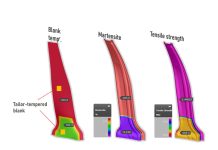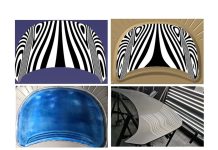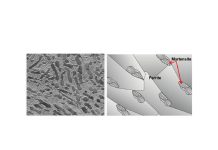
Are all coils created equal? Various coils have potentially different mechanical properties. Source image attribution: www.terexmphs.com
In tryout and production the engineering “boundary conditions” used during simulation are often different than production reality. Physical presses and tools flex, press slides and beds are not perfectly parallel, lubrication is not homogeneous, material properties vary, blank shapes differ, and tool geometry is man-made. In previous posts we discussed that during tryout, if the sheet behavior in the die is not as intended, we might measure and track draw-in to see what adjustments need to occur. That post kicked off discussion regarding the validation of simulation assumptions such as the mechanical properties of the sheet metal, which we will start to address with this post.
How similar or different is the material used for production than the assumed material from engineering analysis?
This question raises two very significant concerns:
- Effectiveness of the material model used to capture the likely behavior of the material
- Where do the mechanical properties used sit among the potential distribution of coil properties
When defining the simulation for advanced feasibility or stamping process engineering, a material description is either imported from available libraries of materials or defined by the analyst from defined limits in the specification. Such material files represent a single set of mechanical properties which might be representative of a minimum requirement, nominal or average values, or typical observed values.
Example:
- Material DP600 (DP350Y600T)
- Minimum Yield Strength (σ0)of 350 MPa
- Minimum Tensile Strength (Rm) of 600 MPa
- Work Hardening Exponent (n or N-value) min of 0.15
- Plastic Anisotropic ratio (rm, Rbar or Rmean) of 0.8
With only this information the engineer has limited options for conducting their work. One common approach would be to “build” a material file using the provided minimums. Most FEA tools for sheet metal stamping allow for definition of the materials in similar ways.

Material definition and results based on minimum values mechanical properties
In this “as-engineered” state, the project may have been approved to proceed and the tools built and shipped. Upon arrival of the completed tools for tryout, first hit results might generate vastly different results.
One potential is that the material is different than the minimum specification, in fact it is certain that the material shipped will differ from the minimum. The combination of all properties at minimum might not be metallurgically possible. Additionally, it is expected that for a given minimum ordered specification that the reality would be higher values; assuming normal distributions of characteristics.

Material properties vary, minimum Yield Strength and minimum n-value are rarely coincident
Material files built using specification minimums may not represent reality well, due to the nature of material behavior where minimum values are not coincident. The combination of minimums in both Y.S. and n-value as shown above with the black squares might not occur naturally. When the minimum Y.S. is present the material may be closer to achieving higher n-values—combination shown in the figure above with the green triangles. Conversely, when n-value is at its minimum Y.S. tends towards the higher end of acceptable ranges—shown above with the red Xs.

Material sample from “typical” heat of DP600 material- 1.6mm
When the same design is run using material parameters based on a “representative” combination of materials taken from a tested sample of real material, which avoids the improbability of coincident minimums, we should observe different formability results. They might appear safer or more critical when looking at issues like splitting and wrinkling. They are without a doubt different, and for issues like springback those differences can be even more apparent.

Material model based on constitutive valuesof typical material delivered
The two examples above are each engineering assumptions based on either minimums or assumed “typical” behavior. They were modeled by taking sets of numbers commonly used to characterize material behavior using simplified factors, constants, and exponents—“constitutive models”. Simple values like these are useful for summation and specification of acceptable mechanical properties or compliance, but can fall short of the needs of accurate simulation as material behavior is more complex than the simplified models these values represent.
Simulating with tested materials
Material models based on tested materials allow the user to better capture realistic behavior. We will see that with tested material raw data available we can avoid issues with extrapolation error common to using simplified “Power law” flow curves, as well as, model more realistic sheet behavior when recognizing that the yield loci will not be isotropic, or uniform in all directions of the sheet. These two changes—the use of the “raw” data as input for a flow-curve or hardening curve, and the input of all three surface directions results for r-values and initial yield strengths—avoid any stack up of error in the parameterization of constitutive material modeling inherent when using derived values as inputs to simulation.

As-shipped material model created from direct import of “raw” test data instead of constitutive values
The behavior of the shipped material is vastly different than the behavior based on the simple input of Y.S., n-value, and R-Value. Using the full material test data we can characterize the flow curve or hardening curve with empirical data, this yields a more meaningful model of material flow and stretching. In the models where we used only input of Y.S. and n-value we are relying on constitutive values which were derived via a curve fit to extrapolate out the full curve behavior; a power-law equation, in the above cases, like Ludwik. Certainly there is potential for extrapolation errors going in both directions—from the test data used to derive the constitutive values, n and Rm, to describe the shape of the entire curve; then again when those values are used to “reconstitute” a complete flow curve.

Material hardening, or flow curves; Dark blue from raw data, light blue from input values
The use of advanced constitutive modelling based on raw tested material data allows us to model sheet behavior more realistically, and therefore has more accurate modeling of forming history. This modeled behavior is often the best available model of behavior of the “as-shipped” material when compared to “as-engineered” expectations.
- What assumptions are you making when it comes to material files for simulation?
- Are you able to use “tested” data as the basis for your material files?
- Which constitutive models do you use to fit hardening curves and yield loci?
- When in tryout do you compare the received material behavior in simulation to observations in tryout?
Your point of view is important to us, let us know what you think. We look forward to expanding on this topic further with discussions on modeling of flow curves or hardening curves, as well as yield surface models and FLC.














[…] of potential variation, or noise, in the production environment besides the already mentioned material properties and drawbead conditions. This post is one in a series that will try to further expand the list of […]
“Material files built using specification minimums may not represent reality well, due to the nature of material behavior where minimum values are not coincident. ” This point can’t be made strongly enough.
Many FEA specialists I know will make the material card based on the minimum values from the specification ranges, without realizing that often those combinations are maybe closer to “ideal” or “best case” if the combination can exist in reality at all.
It is very unlikely that a material with minimum performance in YS and UTS will at the same time have minimum n and R values. Those properties are more close to inversely proportional. Also, the worst case might be better described with Max YS and Min TS as that material would likely have very little range of forming left and bad springback. But then engineering to that worst case would make the part behave very differently when better than expected material arrives, perhaps even resulting in an unsellable part.
We have addressed this in our blog also over the years, maybe your readers will appreciated it http://kam-stampingguru.blogspot.com/2011/04/metal-spec-redux.html
— The-Self-Proclaimed-Die-Expert
[…] instead of using “typical” values for constitutive parameters. To assume input values based on minimum, typical, or nominal n-value, tensile strengths, R-values, and FLC would not be truly representative of the behavior of […]